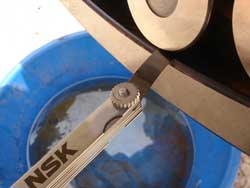
Posted to News on 25th Aug 2011, 13:03
Bearing optimisation in challenging environments
This article from NSK explains the issues surrounding bearings operating in wet or dirty environment, and what steps can be taken to reduce costs through the prevention of premature bearing failures.

The costs associated with premature bearing replacement due to contamination-induced failure can be considerable. In addition to the replacement cost of the bearing itself, and the time and effort involved in sourcing and physically replacing it, there is the cost of unplanned down time, and the effect on production schedules.
A rolling bearing subject to contamination may require replacement at a point in its lifecycle that is a mere fraction of the life expectancy that would otherwise be achieved if operating in a clean environment. This point is underlined by the incidence of bearing failures in challenging environments such as food processing, sewage treatment and agricultural equipment, where machinery is hosed down or exposed to dust, dirt and processed materials.
What must always be borne in mind when using bearings is that they are precision engineered components with very small internal operating clearances: a fact that makes them particularly sensitive to contamination. In many cases, it is the service life of the rolling bearings that dictates the required maintenance effort and, therefore, the availability for service of a machine.
In addition to being forcibly injected by high-pressure washdowns, moisture can be drawn into rolling bearings by the vacuum created as bearing internal air pockets cool after machines shut down. With bearings at standstill, moisture saturates the grease, congregating around the points of contact between balls and raceways. This is evidenced by internal inspection of moisture-contaminated bearings, which will often reveal patches of corrosion on the raceways at the ball spacings. The result of this would be noise and rough running, eventually leading to premature bearing failure.
Dust
Where the problem is dust rather than moisture, the problem may be different but the overall result, bearing failure, is the same. The blotting paper effect of dust ingested into a bearing has the effect of drawing oil away, leaving the bearing with minimal lubrication at the same time as it is struggling to cope with increased friction resulting from the circulation of dust debris. The overall effect of this is that severe internal wear of cage pockets and raceways may occur, and shafts may no longer be rigidly located as a result. This has a knock-on negative effect on the life expectancy of other components in the power train, such as pulleys, chains and sprockets, all of which may require early replacement.
A further consequence of the incidence of increased internal friction in bearings as a result of contamination is creep of the bearing rings. Severe wear to the housing bore or shaft is a likely consequence and this itself can be a cause for mechanical inaccuracy and vibration, not to mention possibly resulting in a more extreme mode of bearing failure such as seizure. In addition, shaft journal damage from bearing inner ring fretting or bearing seizure may necessitate shaft replacement; the expense of this operation being likely to dwarf other replacement costs.
The key to determining the impact of contaminated operating conditions on bearing service life is an analysis of rolling bearing failure modes, through individual bearing examinations combined with consideration of bearing replacement history and applied loads. With this data an assessment can be made of the relative costs of the problem to a business. Moreover, once the problem is recognised it is usually easy to overcome using bearings that are optimised for use in their respective operating environment.
Bearing optimisation
Bearing optimisation can be achieved as part of a structured, company-wide initiative using NSK's Asset Improvement Programme (AIP). The AIP is designed to deliver real benefits in operating costs, efficiency and profitability across all industry sectors. These benefits are achieved by delivering tangible savings to assets, such as equipment and machinery, and also by improving the working knowledge of maintenance and engineering personnel.
As part of an AIP programme, all aspects of a company's operations - including systems, stock, specific problem applications, lubrication, and even training issues - are audited. An analysis of the data acquired is then performed and this leads to recommendations for improvements. In practice, these recommendations could relate to training: about how to examine or look after bearings; how to spot failure modes; and how to handle bearings correctly, as that is one of the biggest causes of premature failure.
In addition, NSK might need to look at the lubrication of bearings; or recommend part substitution for a bearing that would work more effectively. The overall aim is to provide added value through the provision of engineering solutions that, when documented, can represent substantial savings on operating and maintenance budgets.
Contact NSK for more information about its Asset Improvement Programme or use the form on this page.
Want the latest machine building news straight to your inbox? Become a MachineBuilding member for free today >>
Office 4, Arlington Business Park
Gateway 1000
Whittle Way
SG1 2FP
UNITED KINGDOM
0800 634 1909

















